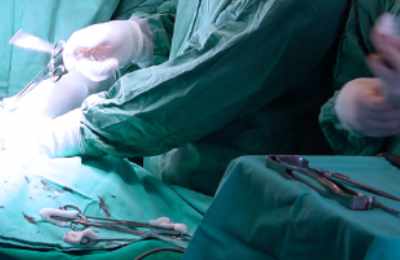Knee surgery includes operating on the structures within the knee capsule, on the soft tissue structures outside the knee capsule or on the bones above or below the joint.
 Page updated July 2023 by Dr Sheila Strover (Clinical Editor)
Page updated July 2023 by Dr Sheila Strover (Clinical Editor)

Surgeons train to familiarise themselves with all aspects of knee surgery, but tend to specialise in one particular area, such as knee replacement, osteotomy or patellar alignment.
Which knee procedures can be done via keyhole surgery?
Keyhole surgery or 'arthroscopy' is the standard technique for dealing with problems within the capsule of the knee joint. Because the capsule is water-tight, a small hole or portal into the joint space allows it to be filled with fluid under pressure so that the interior structures can be easily illuminated and visualised through a tiny camera which is passed into the joint together with necessary instrumentation. Via this technique the surgeon can deal with a wide variety of problems and special fine-stemmed instruments have been developed to deal with the many techniques and issues which may arise.
Which knee procedures require open surgery?
Because keyhole portals are very small it is often necessary to open the knee joint when better access is needed, such as for knee replacement (arthroplasty). Usually a tourniquet is applied on the thigh above the knee before the procedure, and pumped up to stop blood flow to the area during the operation. Before the joint is closed back up the tourniquet is released, and any bleeding stopped by cauterising the small vessels.
Which knee procedures do not involve opening the joint?
Several important structures in the knee are outside of the knee capsule, and there is no need to open the joint itself.
How long does it take to recover from knee surgery?
This is a complicated question. A young healthy person having a simple arthroscopic procedure would expect to be walking with crutches the next day, and quickly progress to a stick for a week or so. Any discomfort may be less from the procedure itself but more from the inflation of the knee with fluid under pressure and the use of a tourniquet to block off the blood flow during the surgery. It takes several days for the swelling to come down enough to comfortably bend the knee.
Some cartilage repair procedures require that no weight is taken on that side for several weeks to allow the cartilage to heal. So the patient has to continue to be non-weight-bearing on crutches during all this time.
Surprisingly knee replacement patients are encouraged to get going as soon as possible. They may be hampered by the poor state the muscles and bones were in before the surgery, as pain may have severely hampered mobility, but the physiotherapist will encourage supported ambulation as soon as possible. A fit person may be up and about with a stick within just a few days.
In all these cases, of course, there should be a rehabilitation programme, gradually building up the range of motion of the knee, and building up and balancing muscle strength and keeping the soft tissues of the knee mobile so that stiffness from adhesions is minimised..
What complications can one expect with routine knee surgery?
With knee surgery there are 'ordinary' complications and 'dreaded' complications. Ordinary complications include internal swelling (effusion or haemarthrosis), weak muscles, stiffness and continuing discomfort. There may be issues relating to any arthroscopy portals, such as oozing, superficial infection or irritating portal scars. Dreaded complications include infection (septic arthritis), complex regional pain syndrome and arthrofibrosis, and of course there may be those remote dreaded complications that may dog any surgical procedure - deep vein thrombosis and pulmonary embolus.
Keyhole surgery procedures -
- Arthroscopy
- Meniscus surgery
- Total meniscectomy
- Partial meniscectomy
- Meniscal trimming
- Meniscal allograft transplantation
- Partial meniscal replacement
- Cruciate ligament reconstruction
- Cruciate repair
- Patellar alignment
- Lateral release
- Lateral retinacular lengthening
- Medial reefing
- Distal realignment
- Proximal realignment
- Arthroscopic trochleoplasty
- Scar tissue releases -
- Plica surgery
- Cartilage repair
Open surgery procedures -
- Arthroplasty (joint replacement)
- Limb alignment
- Extensor mechanism rupture
- Fixation of patellar fractures
- Patellar tendon rupture
- Quads tendon rupture
- Patella alta
- Patella baja
- Regenerative orthopaedics